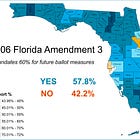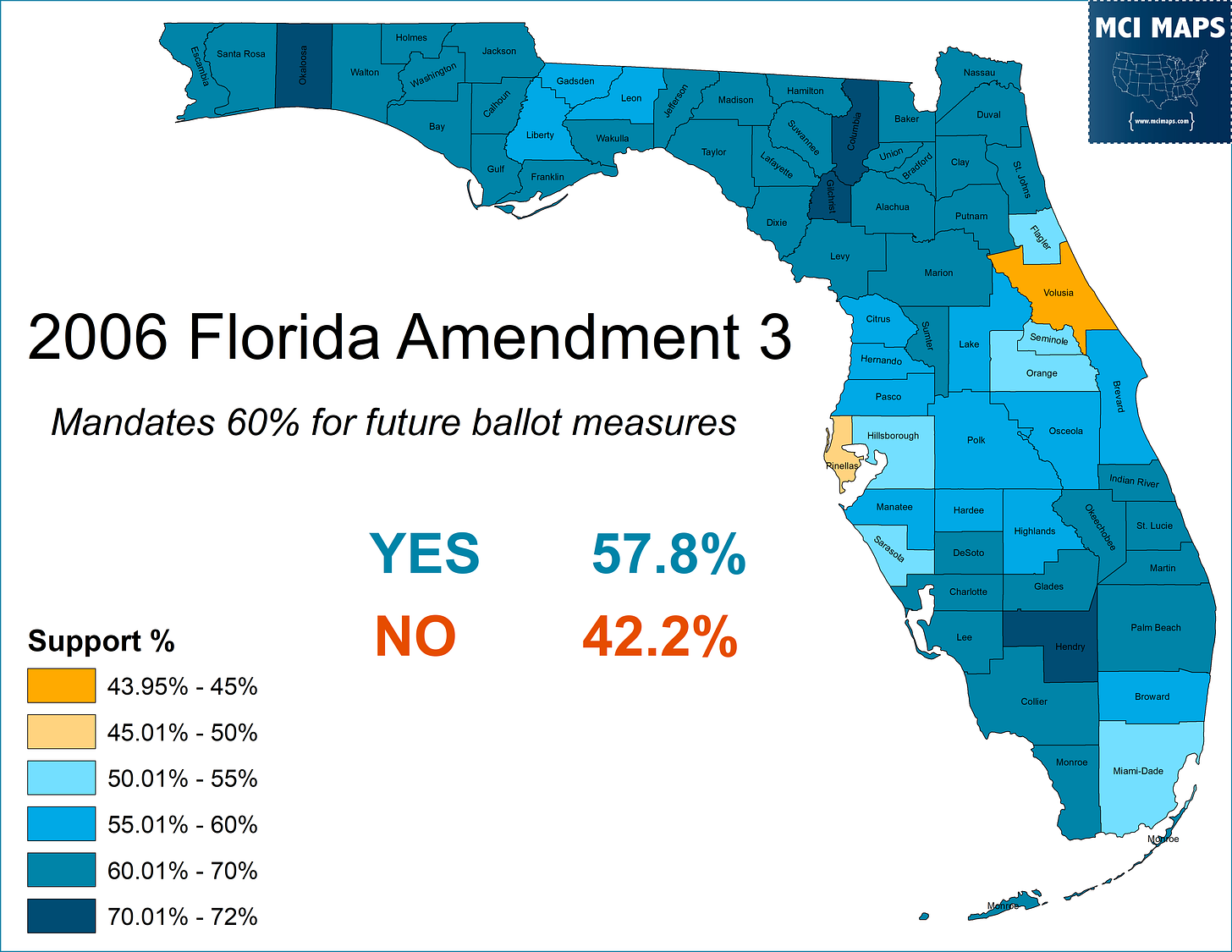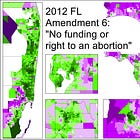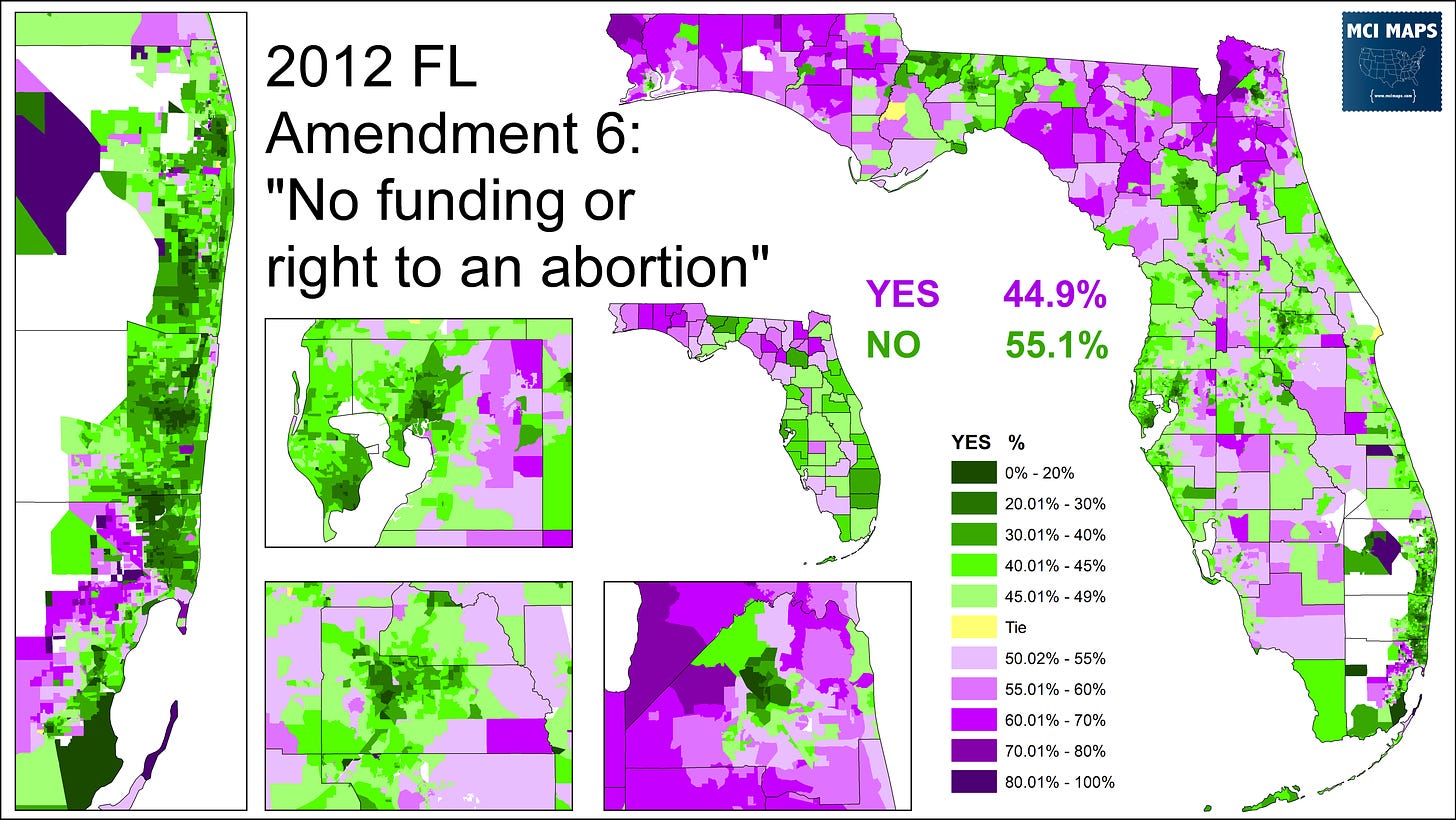Issue #167: Abortion and Weed will be on the Florida Ballot in 2024
Could lead to massive national focus
On Monday, April 1st, (no jokes here) - the Florida Supreme Court approved two petition-driven measures for the 2024 ballot. One would codify abortion rights while the other would legalize marijuana for those over 21.
Both efforts secured the needed signatures some time ago and were awaiting court approval, which had to come by the 1st of the month. There was worry the more conservative-oriented court would find some loophole to reject the measures for the ballot. This did not happen and as a result sets up Florida’s ballot for two major issues the same day as the Presidential and US Senate contests.
I’ve covered many of these topics before and will be linking to plenty of older material. This newsletter will look at 4 key topics….
The state’s 60% rule for ballot measures
The history of abortion on the Florida ballot
The history of marijuana on the Florida ballot
What this could mean for the rest of the ballot
Lets dig in
Why You Need 60%
I want to address the 60% rule for Florida first since its requirement effects how the campaigns for both measures will be run. I wrote about Florida’s 60% rule back in 2023, right before Ohio voted on a similar proposal.
As I discussed in that issue, Florida passed a 60% rule way back in 2006; in a very different political era. These days, many state’s have tried to raise their thresholds as part of right-wing efforts to short-circuit liberal measures. The Ohio effort failed, as have several others. When Florida did it though, it was not as partisan an effort. I discuss the campaign and politics around it much more in that issue, but many groups had reasons for backing it.
Republicans held the legislature and didn’t want competition with their agenda
Business groups wanted stability after years of back and forth measures on regulations
Voters were sick of long ballots filled with niche issues
Liberal voters didn’t mind an increase to stop right-wing measures the legislature and right-wing groups might try and put up
As a result, the proposal to go to 60% passed in 2006 - but with just 58%. LOL
County and precinct data shows many liberals backed the measure and many conservatives opposed it. Your backing really depended what you thought was coming to the ballot next. Myself and many LGBT folks backed the proposal because we knew a gay marriage ban was coming in 2008 or in the near future (which frustratingly got 62% in 2008).
In the long term, the 60% rule has killed more Conservative ballot measures than it has liberal ones. See below.
The only notable lefty measure to fail due to the 60% rule was a medical marijuana measure in 2014. I will talk more about that further into this newsletter. Overall though, this proposal has hurt more right-wing measures. Whether that trend holds, however, depends how the campaigns for abortion and marijuana go this year. So lets discuss these issues.
Abortion Politics in Florida
The 2024 pro-choice measure approved for the ballot lays out a right to an abortion up to viability, and with further guarantees if life and health is at risk. The ballot summary is as follows.
No law shall prohibit, penalize, delay, or restrict abortion before viability or when necessary to protect the patient’s health, as determined by the patient’s healthcare provider. This amendment does not change the Legislature’s constitutional authority to require notification to a parent or guardian before a minor has an abortion.
This is going on the ballot numbered as Amendment 4.
The issue around abortion rights is not a new topic in Florida. Over the last few decades, abortion and the right to privacy have appeared on the Florida ballot several times. I delved more in depth in the issue below, but I’ll cover some key points here as well. Give that a read for a more detailed history.
The backers of the amendment effort had to work to come up with a measure that would offer meaningful protections but also could secure victory in the state. The last line of the measure, making it clear parental notifications still will apply, makes sense when you see how popular parental notification was when it passed in 2004.
Since Florida has the 60% rule, the backers of abortion rights know they must bring in as wide a coalition as possible, including soft pro-lifers. The path to victory there is pretty clear to me. I’m not saying its a lock, but getting to 60% is absolutely doable.
A good starting base is this 2012 measure. The legislature put Amendment 6 on the ballot that year, which aimed to clarify the state’s privacy right did not apply to abortion rights. The YES (pro-life) side only got 45%, strongest in rural areas but not as strong in urban/suburbs.
Now this would of course mean the pro-choice side was at 55%, still below 60%. However, as I have documented before, the post-Dobbs landscape has moved many soft pro-lifers, the same folks voting YES in 2012, to the pro-choice camp. There are whole swaths of voters who would always discuss their unease with abortion but now see the horror stories post-Dobbs and no longer trust the politicians to regulate the issue. A proposal to affirm a right to viability is the type of issue voters right now can get behind. While opponents will be pushing to max out more rural voters, there are alot of exurbs and suburbs that voted YES in 2012 that I can easily see be moved to the pro-choice camp now.
We’ve seen Ohio, Kentucky, and Kansas all vote for the pro-choice sides. I wrote about Kentucky here and Kansas here. I still need to write about Ohio. In Kansas, the effort to pass a measure making it clear abortion rights were not guaranteed failed by a spectacular 17 points. Kentucky voted by 5 points for the pro-choice side the same day it was backing Rand Paul by 20 points. Check out both the Kansas and Kentucky articles for more details on both.
The long and short of it is, I do believe a Florida pro-choice proposal can get 60%. Campaigns will matter, money will matter, but the path is there. Ticket splitting, especially when it comes to things like ballot measures, is very much alive.
Marijuana in Florida
Florida will also be voting on legalizing marijuana for those over 21. The ballot measure summary is laid out as follows
Allows adults 21 years or older to possess, purchase, or use marijuana products and marijuana accessories for non-medical personal consumption by smoking, ingestion, or otherwise; allows Medical Marijuana Treatment Centers, and other state licensed entities, to acquire, cultivate, process, manufacture, sell, and distribute such products and accessories. Applies to Florida law; does not change, or immunize violations of, federal law. Establishes possession limits for personal use. Allows consistent legislation. Defines terms. Provides effective date.
The measure has been designated as Amendment 3.
This push for recreational usage comes just a decade after Florida voters first cast ballots on the issue of marijuana. In 2014, Florida voters gave 58% to a medical marijuana measure. However, since it was under 60%, it did not pass.
This is the biggest left-leaning ballot measure to be killed by the 60% rule. It came for many reasons. The campaign itself, which could have been used to generated improved turnout, did not engage GOTV effectively. The campaign also got tagged hard by opposition spending, heavily funded by casino magnet Sheldon Adelson, who pumped $5 million into the anti-weed efforts. Voters became convinced that the medical rules were far too lose and would just be abused to become back-door recreational. In 2014, recreational definitely would not have passed in Florida. The claims this was all a trick eroded support and the big YES lead slipped in the polls as the fall went on.
While the measure did not secure the 60% it needed, its 15 point margin was still far better than Democrat Charlie Crist, who lost the Florida Governor’s race to Rick Scott by 1 point that same day.
The YES side outperformed Crist almost everywhere, namely worse only with black votes statewide and with Puerto Rican voters around Orlando. Meanwhile many of the rural communities saw YES far outperform the Democratic ticket, something we have seen in many states.
Two years later, the issue of medical marijuana was again put before voters. The measure was written to assure voters this would apply for folks with legitimate medical conditions. Basically it was a “tightened up” re-do. This time, the opposition cash was far lower, with Adelson only throwing in $1.5 million. The YES side won the funding war and voters embraced the new measure, which got a stunning 71%.
No doubt it was helped that turnout was better, but this was also a clear shift in voter sentiment. The measure passed in all but a handful of precincts.
Since 2016, marijuana politics has only trended more in the pro-legalization camp. More and more voters use the substance, especially as that 2016 law proved to be “not so tight.” Here is Speaker Paul Renner, talking to FloridaPolitics,
“And with our medical marijuana protocols, you already can have marijuana available to you for many, many reasons with the doctor’s notes, including in smokable form. So I don’t think there’s a critical need for recreational.”
He isn’t wrong, the medical system right now is very open for voters to get access to marijuana for things ranging from debilitating issues to insomnia and anxiety. This means that the pool of people using it, or who know someone using it, is much higher than ever before; which makes the issue is less scary. Fear mongering will not work as well these days. Don’t get me wrong, I’m not saying passage is a lock, but only that I doubt recreational gets 50% back in 2014. For me the only question now is 60%. The ground is moving quick on public sentiment around marijuana.
Big Democratic Boost?
In addition to the important implications of one or both of these messages passing, many are of course wondering what this means for the partisan ballot in Florida. Anyone who follows me knows I have documented Florida’s right-wing slide. I’ve discussed the problems Florida Democrats (and I mean this broadly as the Democratic side) have in turning the tide. I’ve also discussed how much the 2022 landslides were turnout-driven vs swings in voter sentiment.
However, if we even take 2022 aside, we saw in 2020 that Donald Trump still won Florida by several points. So what does this mean for the Presidential race or US Senate race in Florida?
Well, as I said in the Orlando Sentinel, in a vacuum, these measures only move the needle a bit for Democrats simply by being on the ballot. By default they could gin up enthusiasm among less-likely-to-vote Democrats, but this also really requires a campaign structure for the effect to be especially high. In 2014, I think the effort to turn out voters for medical marijuana was lacking and the turnout issues then reflected that. That year, Republicans had a turnout advantage of 10 points and a vote cast lead of 7 points. This GOP lead was only beaten by the 2022 election.
So simply BEING on the ballot is not enough. However, anyone involved in Florida politics on the right and left has heard the same thing, these measures will have BIG money behind them. That money will not only be for persuasion, but GOTV efforts. Abortion rights groups want to win Florida, the 3rd largest state, not only for the impact it will have on millions of women, but the statement it will send out of DeSantisland. For marijuana groups, the market for legal weed in Florida is a financial windfall, well worth the price of any campaign. All told, expect TENS OF MILLIONS to be spent here by the backers of both amendments; with plenty of that spent on making sure low-propensity left-leaning voters show up.
If that money is spent right, it will cover a lot of financial holes for Democrats. If you have 3rd party groups working to get left-leaning voters out, voters who the Democrats don’t have the cash to reach out to, that is going to benefit Democrats. The big question of course is….. can that flip the Presidency or the Senate race?
Look I am on record with both races as Lean/Likely GOP. But…
Could that change? Yes.
Does national mood also need to move more Democratic for that to happen? Yes.
Do we need to wait on how the money game plays out down here? Yes.
Could Trump and Scott win decent re-elections while both these measures pass anyway? Yes.
There is no magic wand that makes Florida a swing state again. That said, even if the statewide races stay GOP, if they are closer, this can mean the world of differences for a slew of down-ballot campaigns, from state house, to state senate, to Congress, to county commission. All those Democratic candidates have a right to look at this as a good development.
Rising tides lift all boats, and there is no doubt that if you are a Democrat, there is nothing but upside to these measures being on the ballot. Whether that upside is perfectly harnessed, only time will tell.














Great piece. Thank you!
If the Democrats can simply turn out the vote, they can sail through.